Complete Solutions to Single Correct of chapter SOUND WAVES AND DOPPLER EFFECT of Class 11 book with complete answers and questions
| Class 11 | PHYSICS |
| Chapter | SOUND WAVES AND DOPPLER EFFECT |
| CENGAGE PHYSICS | Single Correct |
| Number Of Questions | 100 |
| Academic Year | 2023-24 |
A man is watching two trains, one leaving and the other coming in with equal speed of 4 m/s. If they sound their whistles, each of frequency 240 Hz, the number of beats heard by the man (velocity of sound in air is `320(m)/(s)`) will be equal to
03:29View SolutionThe intensity of a sound wave gets reduced by `20%` on passing through a slab. The reduction intensity on passage through two such consecutive slabs
02:03View SolutionTwo factories are sounding their sirens at 800 Hz. A man goes from one factory to the other at a speed of 2 m/s. The velocity of sound is 320 m/s. The number of beats heard by the person is 1 s will be
03:34View SolutionTwo sources A and B are sounding notes of frequency 680 Hz. A listener moves from A to B with a constant velocity u. If the speed of sound is 340 m/s, What must be the value of u so that he hears 10 beats per second?
03:19View SolutionA train has just completed a U-curve in a trach which is a semi circle. The engine is at the forward end of the semi circular part of the trach while the last carriage is at the rear end of the semi circular track. The driver blows a whistle of frequency 200 Hz. Velocity of sound is `340(m)/(s)`. Then the apparent frequency as observed by a passenger in the middle of the train, when the speed of the train is 30 m/s, is
04:18View SolutionOne train is approaching an observer at rest and another train is receding from him with the same velocity `4 m//s` . Both trains blow whistles of same frequency of `243 H_(Z)` . The beat frequency in `H_(Z)` as heard by observer is (speed of sound in air = `320 m//s`)
04:02View SolutionTwo sound sources are moving in opposite directions with velocities ` v_(1) and v_(2) ( v_(1) gt v_(2))` . Both are moving away from a stationary observer. The frequency of both the sources is 900 Hz. What is the value of ` v_(1) - v_(2)` so that the beat frequency aboserved by the observer is 6 Hz. speed of sound v= 300 m/s given ,that `v_(1) and v_(2) lt lt v `
03:19View Solutionthe frequency changes by 10 % as the source approaches a stationary observer with constant speed `v_(s)`. What would be the percentage change in frequency as the sources reaccedes the observer with the same speed ? Given , that `v_(s)lt lt v `(v= speed pf sound in air )
04:20View Solutionspeed of sound wave is v. if a reflector moves toward a stationary source emiting waves of frequency with speed u, the wavelength of reflected wave will be
02:52View SolutionAn observer moves towards a stationary source of sound with a speed `1/5`th of the speed of sound. The wavelength and frequency of the source emited are `lamda` and f, respectively. The apparent frequency and wavelength recorded by the observer are, respectively-
(a) `f,1.2 lambda` (b) `0.8f,0.8lambda` (c) `1.2f,1.2lambda` (d) `1.2f,lambda`03:08View SolutionA source of sound S is moving with a velocity of `50m//s` towards a stationary observer. The observer measures the frequency of the source as 1000 Hz. What will be the apparent frequency of the source when it is moving away from the observer after crossing him? (take velocity of sound in air is `350m//s`)
03:48View SolutionA whistle emitting a sound of frequency `440 Hz` is tied to a string of `1.5 m` length and roated with an angular velocity of `20 rad//s` in the horizontal plane. Calculate the range of frequencies heard by an observer stationed at a larger distance from the whistle .(Speed of sound =`330 m//s)` .
04:16View SolutionA band playing music at a frequency v is moving towards a wall at a speed `v_(b)`. A motorist is following the band with a speed `v_(m)`.If v is the speed of sound, the expression for the beat frequency heard by the motorist is
03:49View SolutionA man standing on a platform hears the sound of frequency 604 Hz coming from a frequency 550 Hz from a train whistle moving towards the platform. If the velocity of sound is 330 m/s, then what is the speed of train?
02:33View SolutionA vehicle , with a horn of frequency `n` is moving with a velocity of `30 m//s` in a direction prependicular to the straight line joining the observer and the vehicle . The observer perceives the sound to have a grequency `(n + n_(1))` . If the sound velocity in air is `330 m//s` , then
02:50View SolutionAn isotropic stationary source is emitting waves of frequency n and wind is blowing due north. An observer A is on north of the source while observer B is on south the source. IF both the observers are stationary, then
02:26View SolutionA train is moving with a constant speed along a cirular track. The engine of the train emits a sound of frequency f. the frequcency heard by the guard a rear end of the train/
01:37View SolutionAn observer moves towards a stationary source of sound with a velocity one-fifth of the velocity of sound. What is the percentage increase in the apparent frequency?
02:31View SolutionAn increase in intensity level of 1 dB implies an increase in intensity of (given anti `log_(10)0.1=1.2589`)
02:59View SolutionIn expressing sound intensity we take `10^(-12)(W)/(m^2)` as the reference level. For ordinary conversation the intensity level is about `10^-6(W)/(m^2)`. Expressed in decibel, this is
01:48View SolutionThe intensity level of two sounds are 100 dB and 50 dB. What is the ratio of their intensities?
02:24View SolutionAn engine running at speed `(v)/(10)` sounds a whistle of frequency 600 Hz. A passenger in a train coming from the oppsite side at speed of `(v)/(15)` experiences this whistle to be of frequency f. If v is speed of sound in air and there is no wind. F is nearest to
02:36View SolutionA source of sound produces waves of wavelength 60 cm when it is stationary if the speed of sound in air is `320(m)/(s)` and source moves with speed `20(m)/(s)`, the wavelength of sound in the forward direction will be nearest to
02:03View SolutionThe apparent frequency of the whistle of an engine changes in the ratio 6:5 as the engine passes a stationary observer. If the velocity of sound is `330(m)/(s)`, then the velocity of the engine is
03:11View Solution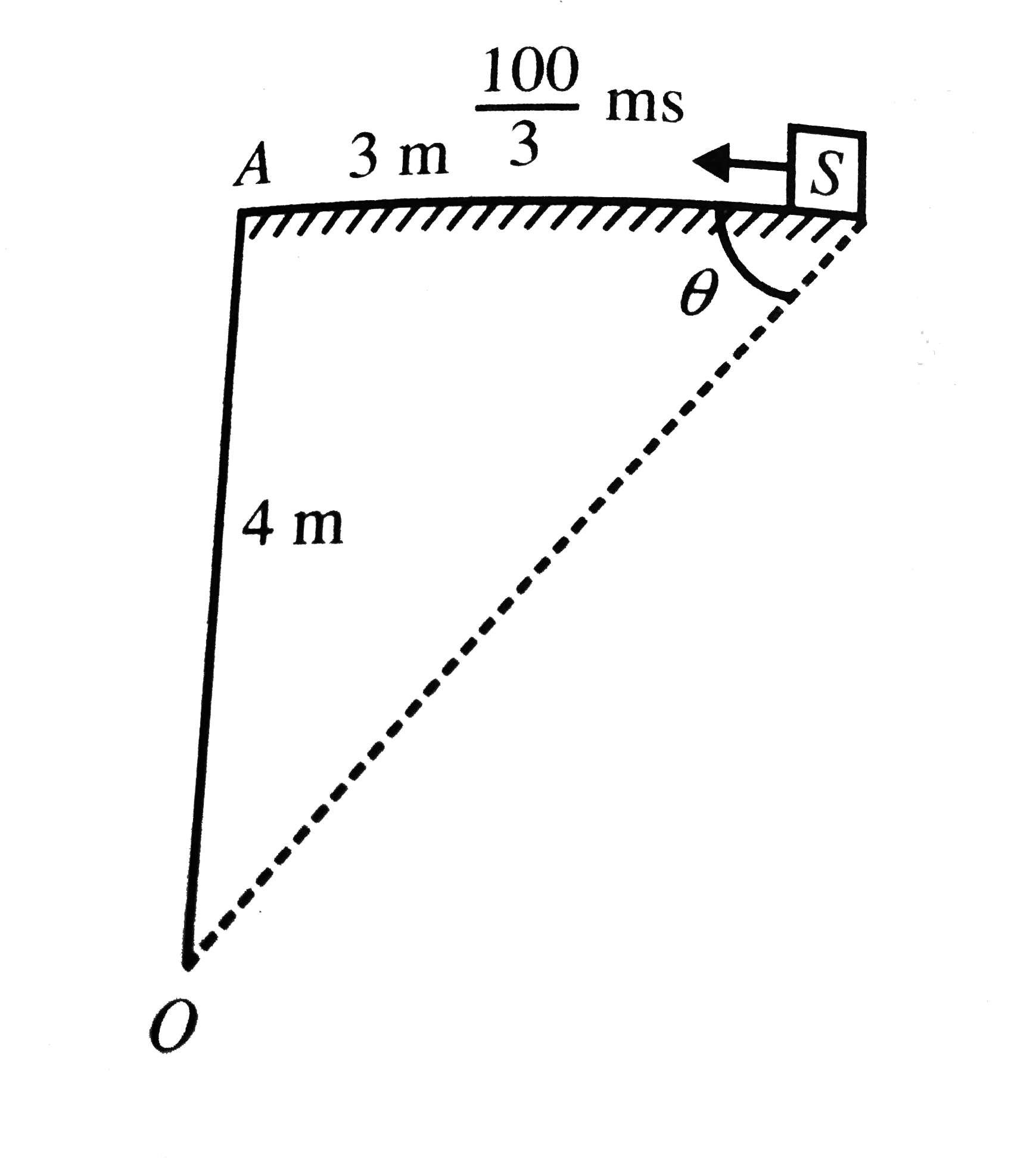
A source of sound S is travelling at `(100)/(3)(m)/(s)` along a road, towards a point A. When the source is 3 m away from A, a person standint at a point O on a road perpendicular to AS hears a sound of requency `v'`. The distance of O from A at that time is 4 m. If the original frequency is 640 Hz, then the value of `v'` is (velocity of sound is `340(m)/(s)`)04:07View SolutionA source of sound is travelling with a velocity of `30(m)/(s)` towards a stationary observer. If actual frequency of source is 1000 Hz and the wind is blowing with velocity `20(m)/(s)` in a direction at `60^@C` with the direction of motion of source, then the apparent frequency heard by observer is (speed of sound is `340(m)/(s)`)
04:34View SolutionA source of sound emits 200`piW` power which is uniformly distributed over a sphere of radius 10 m. What is the loudness of sound on the surface of the sphere?
03:16View SolutionTwo cars are moving on two perpendicular roads towards a crossing with uniform speeds of `72(km)/(h)` and `36(km)/(h)`. If second car blows born of frequency 280 Hz, then the frequency of horn heard by the driver of first car when the line joining the cars makes angle of `45^@C` with the roads, will be (velocity of sound is `330(m)/(s)`)
04:02View Solution
A tuning fork of frequency 380 Hz is moving towards a wall with a velocity of `4(m)/(s)` Then the number of beats heard by a stationary listener between direct and reflected sound will be (velocity of sound in air is `340(m)/(s)`)01:40View Solution
A sound wave of frequency n travels horizontally to the right with speed with speed c. It is reflected from a broad wall moving to the left with speed v. The number of beats heard by a stationary observer to the left of the wall is02:55View SolutionA boy is walking away from a well at a speed of `1.0 m//s` in a direction at right angles to the wall. As he walks, he below a whistle steadily. An observer towards whom the boy is walking hears `4.0` beats per second. If the speed of sound is `340 m//s` , what is the frequency of the whistle?
04:35View SolutionA source emitting a sound of frequency f is placed at a large distance from an observer. The source starts moving towards the observer with a uniform acceleration a. Find the frequency heard by the observer corresponding to the wave emitted just after the source starts. The speed of sound in the medium is v.
04:52View SolutionDue to a point isotropic sonic source, loudness at a point is `L=60dB` If density of air is `rho=((15)/(11))(kg)/(m^3)` and velocity of sound in air is `v=33(m)/(s)`, the pressure oscillation amplitude at the point of observation is `[I_0=10^-12(W)/(m^2)`]
03:33View SolutionThe frequency of a car horm is 400 Hz. If the horn is honked as the car moves with a speed `u_S=34(m)/(s)` through still air towards a stationary receiver, the wavelength of the sound passing the receiver is [velocity of sound is `340(m)/(s)`]
02:02View SolutionSpherical sound waves are emitted uniformly in all direction from a point source. The variation in sound level SL. As a function of distance r from the source can be written as where a and b are positive constants.
02:54View SolutionWhen a person wears a hearing aid, the sound intensity level increases by 30 dB. The sound intensity increases by
02:23View SolutionA motorcycle starts from rest and accelerates along a straight line at `2.2(m)/(s^2)`. The speed of sound is `330(m)/(s)`. A siren at the starting point remains stationary. When the driver hears the frequency of the siren at `90%` of when motorcycle is stationary, the distance travelled by the motorcyclist is
03:20View SolutionThe difference in the speeds of sound in air at `-5^@C`, 60 cm pressure of mercury and `30^@C`, 75 cm pressure of mercury is (velocity of sound in air at `0^@C` is `332(m)/(s)`)
02:51View Solution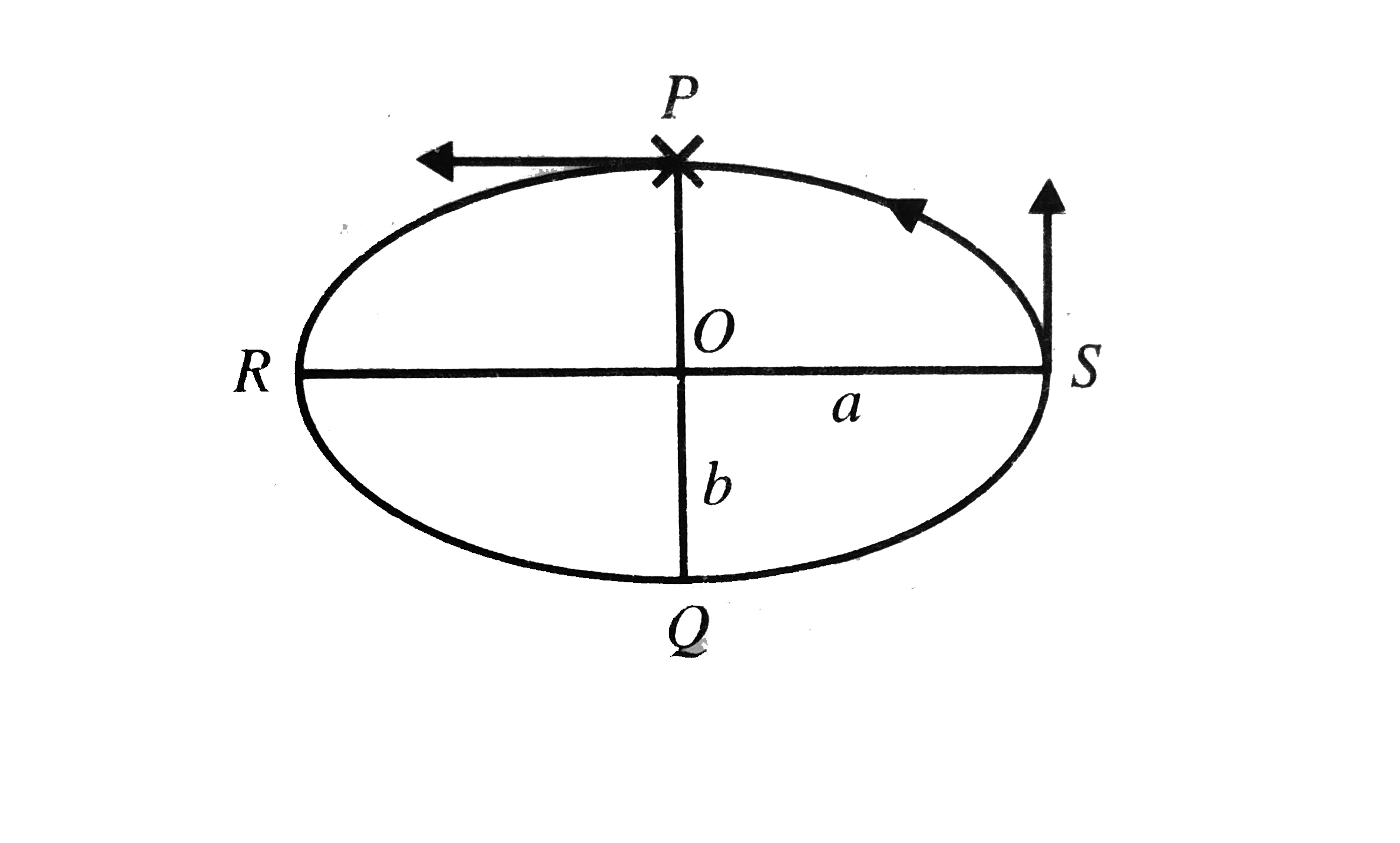
A train is moving in an elliptical orbit in anticlockwise sense with a speed of `110(m)/(s)`. Guard is also moving in the given direction with same speed as that of train. The ratio of the length of major and minor axes is `(4)/(3)`. Driver blows a whistle of 1900 Hz at P, which is received by guard at S. The frequency received by guard is (velocity of sound `v=330(m)/(s)`)03:46View Solution
A stationary observer receives a sound from a sound of freqeuency `v_0` moving with a constant velocity `v_S=30(m)/(s)` The apparent frequency varies with time as shown in figure. Velocity of sound `v=300(m)/(s)`. Then which of the following is incorrect?04:34View SolutionThe sound from a very high burst of fireworks takes 5 s to arrive at the observer. The burst occurs 1662 m above the observer and travels vertically through two stratifier layers of air, the top one of thickness `d_1` at `0^@C` and the bottom one of thickness `d_2` at `20^@C`. Then (assume velocity of sound at `0^@C` is `330(m)/(s)`)
05:53View SolutionA car emitting sound of frequency 500 Hz speeds towards a fixed wall at `4(m)/(s)`. An observer in the car hears both the source frequency as well as the frequency of sound reflected from the wall. If he hears 10 beats per second between the two sounds, the velocity of sound in air will be
04:32View Solution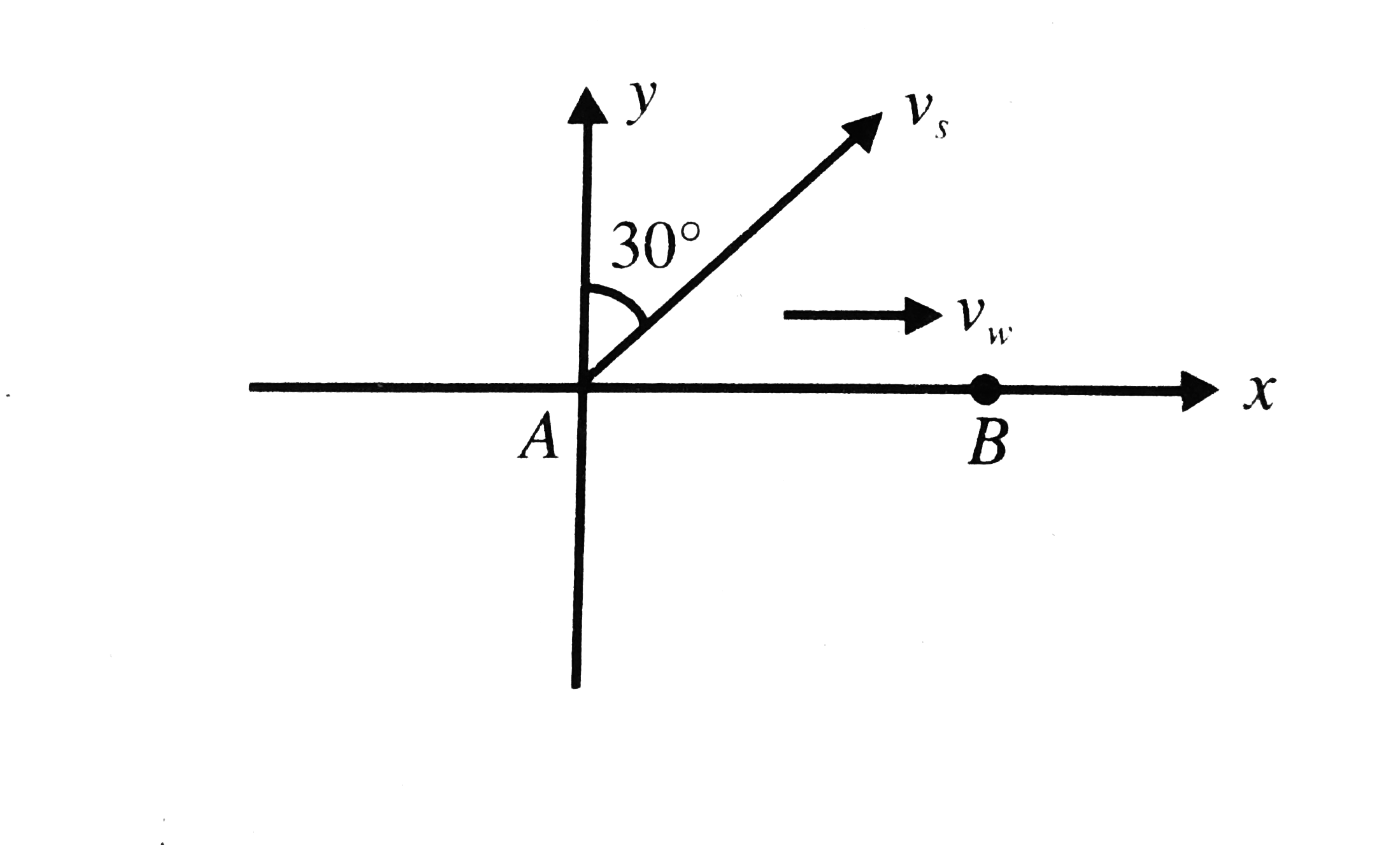
In the figure shown, a source of sound of frequency 510 Hz moves with constant velocity `v_S=20(m)/(s)` in the direction shown. The wind is blowing at a constant velocity `v_W=20(m)/(s)` towards an observer who is at rest at point B. corresponding to the sound emitted by the source at initial position A, the frequency detected by the observer is equal to (speed of sound relative to air is `330(m)/(s)`)03:01View Solution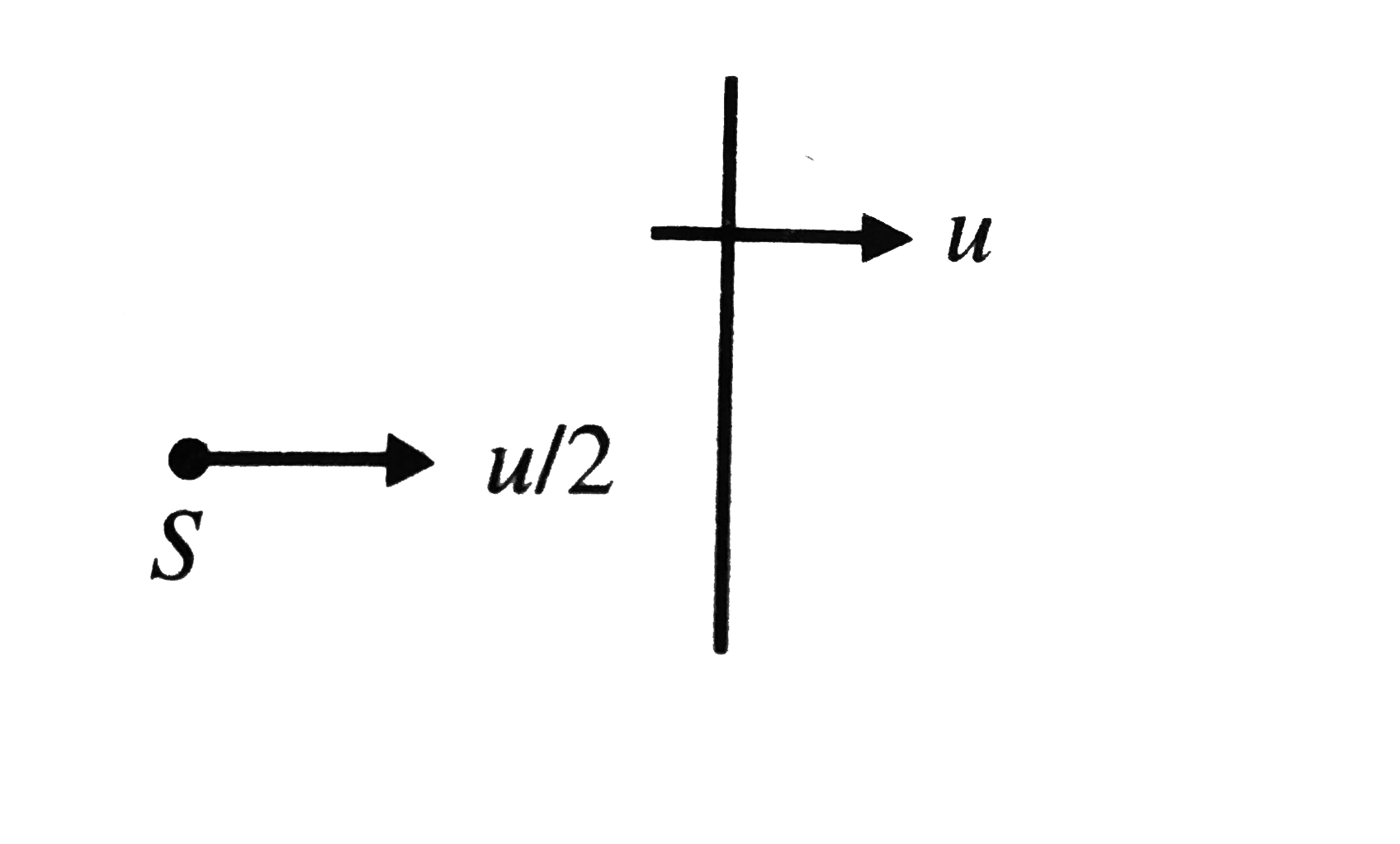
A wall is moving with velocity u and a source of sound moves with velocity `(u)/(2)` in the same direction as shown in the figure. Assuming that the sound travels with velocity `10u`, the ratio of incident sound wavelength on the wall to the reflected sound wavelength by the wall is equal to03:31View Solution
For a sound wave travelling towards `+x` direction, sinusoidal longitudinal displacement `epsi` at a certain time is given as a function of `x` (Fig). If bulk modulus of air is `B=5xx10^5(N)/(m^2)`, the variation of pressure excess will be03:20View SolutionIf the source is moving towards right, wavefront of sound waves get modifies to
01:52View SolutionConsider a source of sound `S` and an observer `P`. The sound source is of frequency `n_0`. The frequency observed be `P` is found to be `n_1` if `P` approaches `S` at speed `v` and `S` is stationary, `n_2` If `S` approaches `P` at a speed `v` and `P` is stationary and `n_3` if each of `P` and `S` has speed `(v)/(2)` towards one another Now.
03:20View SolutionWhen source and detector are stationary but the wind is blowing at speed `v_W`, the apparent wavelength `lamda'` on the wind side is related to actual wavelength `lamda` by [take speed of sound is air as v]
01:32View Solution
Figure. Represents the displacement `y` versus distance `x` along the direction of propagation of a longitudinal wave. The pressure is maximum at position marked02:15View SolutionThe driver of a car approaching a vertical wall notices that the frequency of the horn of his car changes from 400 Hz to 450 Hz after being reflected from the wall. Assuming speed of sound to be `340(m)/(s)`, the speed of approach of car towards the wall is
03:06View SolutionThe difference between the apparent frequency of a source of sound as perceived by the observer during its approach and recession is 2% of the natural frequency of the source. If the velocity of sound in air is 300 m/s, the velocity of the source is
05:05View SolutionThe freqency of a radar is 780 M hz. The frequency of the reflected wave from an aerolane is increased by 2.6 kHz. The velocity of aeroplane is
03:04View SolutionA train moves towards a stationary observer with speed `34 m//s`. The train sound a whistle and its frequency registered by the observer by the observer is `f_(1)`. If the train's speed is reduced to `17 m//s`, the frequency registered is `f_(2)`. If the speed of sound is `340 m//s`, then the ratio `f_(1)//f_(2)` is
03:49View SolutionA siren placed at a railway platfrom is emitted sound of frequency `5 kH_(Z)`, A passenger sitting in retun journey in a different train `B` he records a frequency of `6.0 kH_(Z)` while approaching the same siren. The ratio of the velocity of train `B` to that of train `A` is
03:04View SolutionA person speaking normally produces a sound intensity of 40dB at a distance of 1m. If the threshold intensity for reasonable audibility is 20dB, the maximum distance at which a person can be heard clearly is (2x) meter . Find the value of x.
04:16View Solution
A police car moving at `22m//s`, chases a motorcyclist, the police man sounds his horn at `176 Hz`, while both of them move towards a stationary siren of frequency `165 H`z. Calculate the speed of the motorcycle, if it is given that he does not observes any beat03:53View SolutionIn sport meet the timing of a 200 m straight dash is recorded at the finish point by starting an accurate stop watch on hearing the sound of starting gun firen at the starting poing. The time recorded will be more accurate
03:10View SolutionWhen a source moves away from a stationary observer, the frequency is `(6)/(7)` times the original frequency. Given: speed of sound `=330(m)/(s)` . The speed of the source is
02:57View SolutionIf `v_(0)` be the orbital velocity of an articial satellite orbital velocity of the same satellite orbiting at an altitude equal to earth's radius is
02:30View SolutionSource and observer start moving simulatneously along x and y-axis respectively. The speed of source is twice the speed of observer `V_0`. If the ratio of observer frequency to the frequency of the source is `0.75`, find the velocity of sound.
04:15View Solution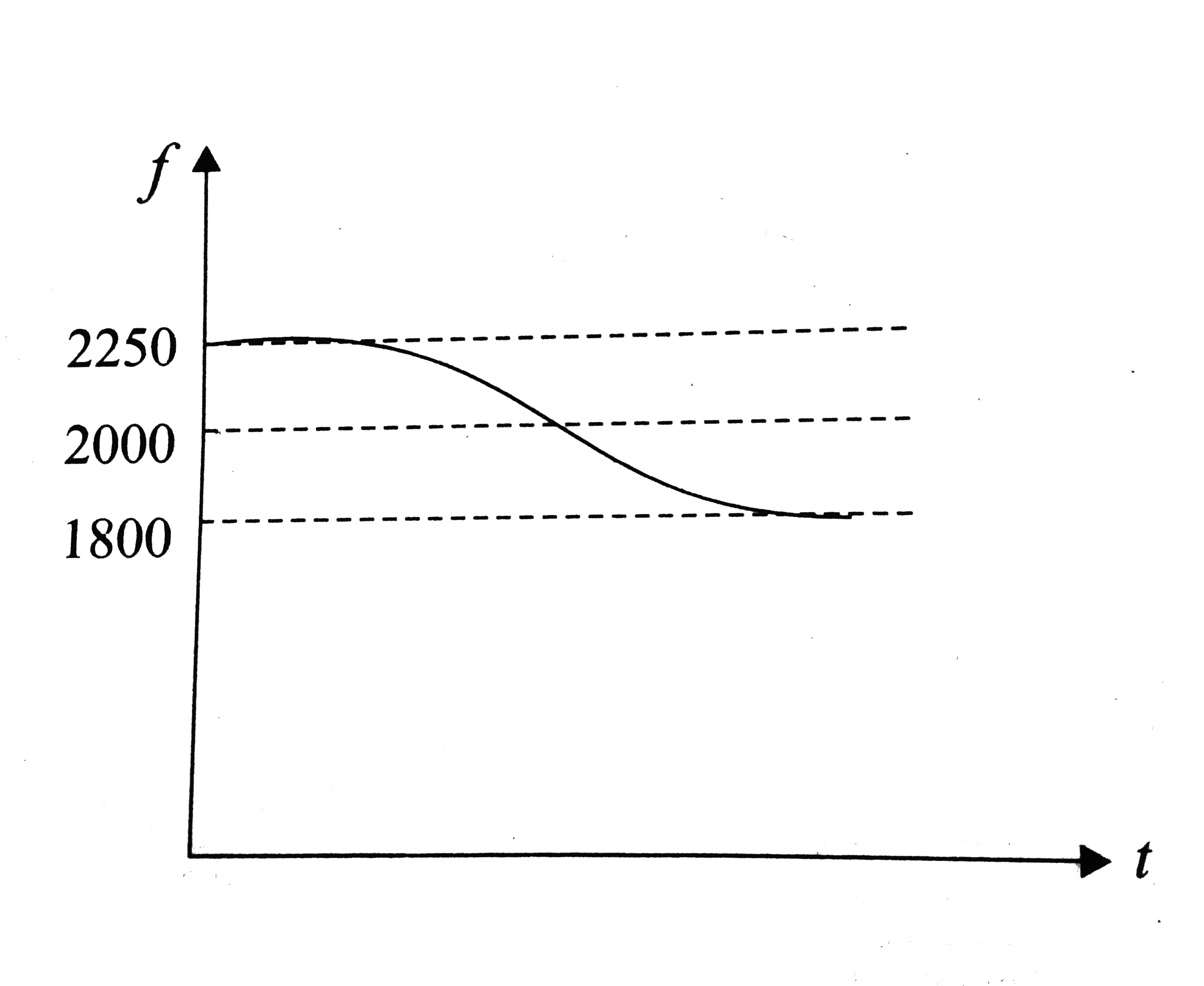
A statinary observer receives a sound of frequency 2000 Hz. The variation of apparent frequency and time is shown. Find the speed of source, if velocity of sound is `300(m)/(s)`02:37View Solution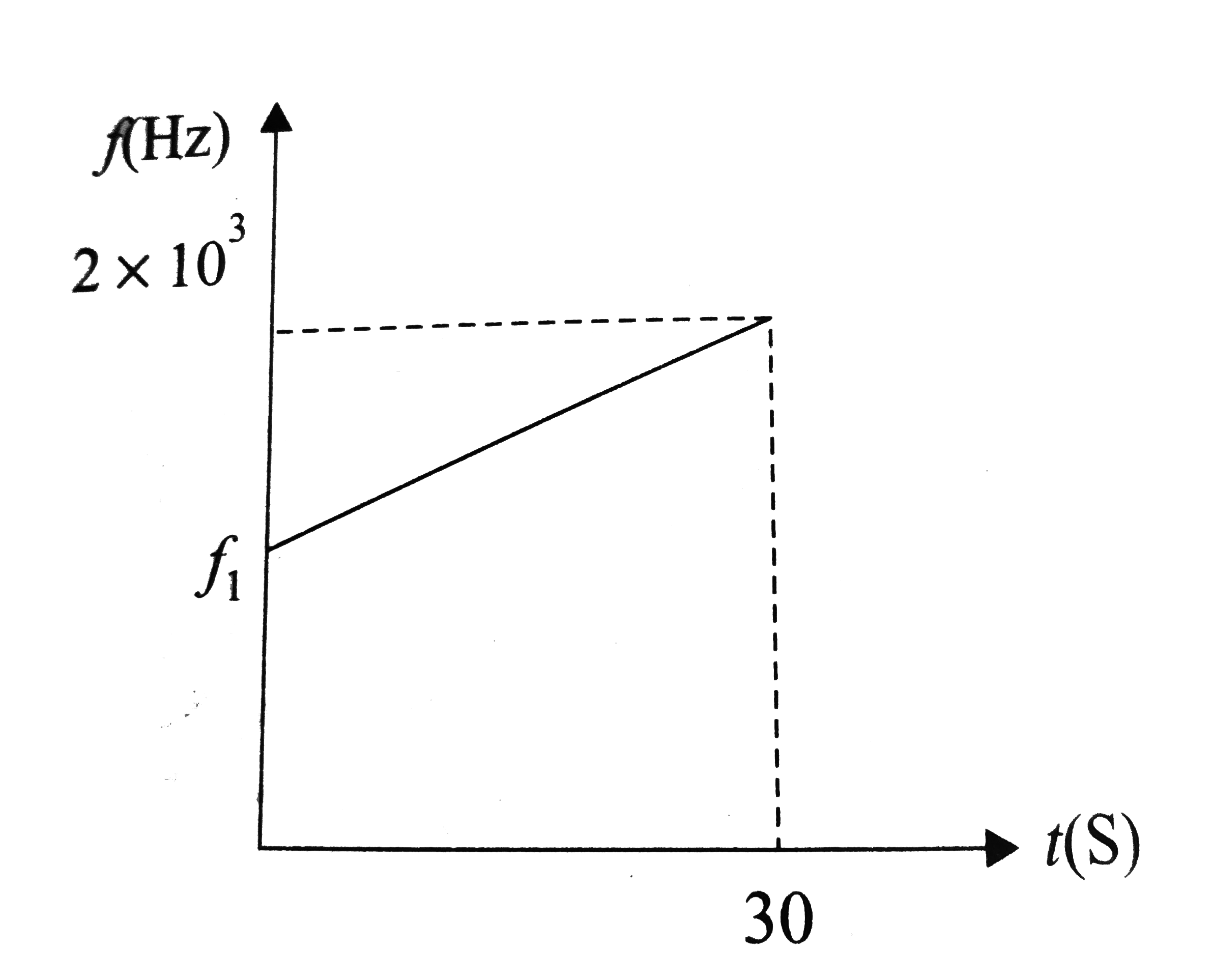
A source of sound of frequency `f_1` is placed on the ground. A detector placed at a height is released from rest on this source. The observed frequency `f(Hz)` is plotted against time `t(sec)` . The speed of sound in air is `300(m)/(s)`. Find `f_1` (`g=10(m)/(s)`).03:22View SolutionA sound wave of frequency `f` travels horizontally to the right . It is teflected from a larger vertical plane surface moving to left with a speed `v`. the speed of sound in medium is `c`
(a) The number of waves striking the surface per second is `f(c + upsilon)/(c)`
(b) The wavelength of reflected wave is `(c(c-upsilon))/(f(c+upsilon))`
(c) The frequency of the reflected wave is ` f((c+upsilon))/((c+upsilon))`
(d) The number of beats heard by a stationary listener to the left of the reflecting surface is `(upsilon f)/(c - upsilon)`06:24View SolutionA man is watching two trains, one leaving and the other coming in with equal speed of 4 m/s. If they sound their whistles, each of frequency 240 Hz, the number of beats heard by the man (velocity of sound in air is `320(m)/(s)`) will be equal to
03:29View SolutionThe intensity of a sound wave gets reduced by `20%` on passing through a slab. The reduction intensity on passage through two such consecutive slabs
02:03View SolutionTwo factories are sounding their sirens at 800 Hz. A man goes from one factory to the other at a speed of 2 m/s. The velocity of sound is 320 m/s. The number of beats heard by the person is 1 s will be
03:34View SolutionTwo sources A and B are sounding notes of frequency 680 Hz. A listener moves from A to B with a constant velocity u. If the speed of sound is 340 m/s, What must be the value of u so that he hears 10 beats per second?
03:19View SolutionA train has just completed a U-curve in a trach which is a semi circle. The engine is at the forward end of the semi circular part of the trach while the last carriage is at the rear end of the semi circular track. The driver blows a whistle of frequency 200 Hz. Velocity of sound is `340(m)/(s)`. Then the apparent frequency as observed by a passenger in the middle of the train, when the speed of the train is 30 m/s, is
04:18View SolutionOne train is approaching an observer at rest and another train is receding from him with the same velocity `4 m//s` . Both trains blow whistles of same frequency of `243 H_(Z)` . The beat frequency in `H_(Z)` as heard by observer is (speed of sound in air = `320 m//s`)
04:02View SolutionTwo sound sources are moving in opposite directions with velocities ` v_(1) and v_(2) ( v_(1) gt v_(2))` . Both are moving away from a stationary observer. The frequency of both the sources is 900 Hz. What is the value of ` v_(1) - v_(2)` so that the beat frequency aboserved by the observer is 6 Hz. speed of sound v= 300 m/s given ,that `v_(1) and v_(2) lt lt v `
03:19View Solutionthe frequency changes by 10 % as the source approaches a stationary observer with constant speed `v_(s)`. What would be the percentage change in frequency as the sources reaccedes the observer with the same speed ? Given , that `v_(s)lt lt v `(v= speed pf sound in air )
04:20View Solutionspeed of sound wave is v. if a reflector moves toward a stationary source emiting waves of frequency with speed u, the wavelength of reflected wave will be
02:52View SolutionAn observer moves towards a stationary source of sound with a speed `((1)/(5))`th of the speed of sound. The wavelength and frequency of the source emitted are `lamda` and f, respectively. The apparent frequency and wavelength recorded by the observer are, respectively.
01:56View SolutionA source of sound S is moving with a velocity of `50m//s` towards a stationary observer. The observer measures the frequency of the source as 1000 Hz. What will be the apparent frequency of the source as 1000 Hz. What will be the apparent frequency of the source when it is moving away from the observer after crossing him? The velocity of the sound in the medium is `350m//s`
03:07View SolutionA whistle emitting a sound of frequency `440 Hz` is tied to a string of `1.5 m` length and roated with an angular velocity of `20 rad//s` in the horizontal plane. Calculate the range of frequencies heard by an observer stationed at a larger distance from the whistle .(Speed of sound =`330 m//s)` .
04:16View SolutionA band playing music at a frequency v is moving towards a wall at a speed `v_(b)`. A motorist is following the band with a speed `v_(m)`.If v is the speed of sound, the expression for the beat frequency heard by the motorist is
03:49View SolutionA man standing on a platform hears the sound of frequency 604 Hz coming from a frequency 550 Hz from a train whistle moving towards the platform. If the velocity of sound is 330 m/s, then what is the speed of train?
02:33View SolutionA vehicle , with a horn of frequency `n` is moving with a velocity of `30 m//s` in a direction prependicular to the straight line joining the observer and the vehicle . The observer perceives the sound to have a grequency `(n + n_(1))` . If the sound velocity in air is `330 m//s` , then
02:50View SolutionAn isotropic stationary source is emitting waves of frequency n and wind is blowing due north. An observer A is on north of the source while observer B is on south the source. IF both the observers are stationary, then
02:26View SolutionA train is moving with a constant speed along a cirular track. The engine of the train emits a sound of frequency f. the frequcency heard by the guard a rear end of the train/
01:37View SolutionAn observer moves towards a stationary source of sound with a velocity one-fifth of the velocity of sound. What is the percentage increase in the apparent frequency?
02:31View SolutionAn increase in intensity level of 1 dB implies an increase in intensity of (given anti `log_(10)0.1=1.2589`)
02:59View SolutionIn expressing sound intensity we take `10^(-12)(W)/(m^2)` as the reference level. For ordinary conversation the intensity level is about `10^-6(W)/(m^2)`. Expressed in decibel, this is
01:48View SolutionThe intensity level of two sounds are 100 dB and 50 dB. What is the ratio of their intensities?
02:24View SolutionAn engine running at speed `(v)/(10)` sounds a whistle of frequency 600 Hz. A passenger in a train coming from the oppsite side at speed of `(v)/(15)` experiences this whistle to be of frequency f. If v is speed of sound in air and there is no wind. F is nearest to
02:36View SolutionA source of sound produces waves of wavelength 60 cm when it is stationary if the speed of sound in air is `320(m)/(s)` and source moves with speed `20(m)/(s)`, the wavelength of sound in the forward direction will be nearest to
02:03View SolutionThe apparent frequency of the whistle of an engine changes in the ratio 6:5 as the engine passes a stationary observer. If the velocity of sound is `330(m)/(s)`, then the velocity of the engine is
03:11View Solution
A source of sound S is travelling at `(100)/(3)(m)/(s)` along a road, towards a point A. When the source is 3 m away from A, a person standint at a point O on a road perpendicular to AS hears a sound of requency `v'`. The distance of O from A at that time is 4 m. If the original frequency is 640 Hz, then the value of `v'` is (velocity of sound is `340(m)/(s)`)04:07View SolutionA source of sound is travelling with a velocity of `30(m)/(s)` towards a stationary observer. If actual frequency of source is 1000 Hz and the wind is blowing with velocity `20(m)/(s)` in a direction at `60^@C` with the direction of motion of source, then the apparent frequency heard by observer is (speed of sound is `340(m)/(s)`)
04:34View SolutionA source of sound emits 200`piW` power which is uniformly distributed over a sphere of radius 10 m. What is the loudness of sound on the surface of the sphere?
03:16View SolutionTwo cars are moving on two perpendicular roads towards a crossing with uniform speeds of `72(km)/(h)` and `36(km)/(h)`. If second car blows horn of frequency 280 Hz, then the frequency of horn heard by the driver of first car when the line joining the cars makes angle of `45^@C` with the roads, will be (velocity of sound is `330(m)/(s)`)
04:40View Solution
A tuning fork of frequency 380 Hz is moving towards a wall with a velocity of `4(m)/(s)` Then the number of beats heard by a stationary listener between direct and reflected sound will be (velocity of sound in air is `340(m)/(s)`)01:40View Solution
A sound wave of frequency n travels horizontally to the right with speed with speed c. It is reflected from a broad wall moving to the left with speed v. The number of beats heard by a stationary observer to the left of the wall is04:00View SolutionA boy is walking away from a well at a speed of `1.0 m//s` in a direction at right angles to the wall. As he walks, he below a whistle steadily. An observer towards whom the boy is walking hears `4.0` beats per second. If the speed of sound is `340 m//s` , what is the frequency of the whistle?
04:35View SolutionA source emitting a sound of frequency f is placed at a large distance from an observer. The source starts moving towards the observer with a uniform acceleration a. Find the frequency heard by the observer corresponding to the wave emitted just after the source starts. The speed of sound in the medium is v.
04:52View SolutionDue to a point isotropic sonic source, loudness at a point is `L=60dB` If density of air is `rho=((15)/(11))(kg)/(m^3)` and velocity of sound in air is `v=33(m)/(s)`, the pressure oscillation amplitude at the point of observation is `[I_0=10^-12(W)/(m^2)`]
03:33View SolutionThe frequency of a car horm is 400 Hz. If the horn is honked as the car moves with a speed `u_S=34(m)/(s)` through still air towards a stationary receiver, the wavelength of the sound passing the receiver is [velocity of sound is `340(m)/(s)`]
02:02View SolutionSpherical sound waves are emitted uniformly in all direction from a point source. The variation in sound level SL. As a function of distance r from the source can be written as where a and b are positive constants.
02:54View SolutionWhen a person wears a hearing aid, the sound intensity level increases by 30 dB. The sound intensity increases by
02:23View SolutionA motorcycle starts from rest and accelerates along a straight line at `2.2(m)/(s^2)`. The speed of sound is `330(m)/(s)`. A siren at the starting point remains stationary. When the driver hears the frequency of the siren at `90%` of when motorcycle is stationary, the distance travelled by the motorcyclist is
03:20View Solution
Single Correct questions and complete solutions for chapter SOUND WAVES AND DOPPLER EFFECT of CENGAGE PHYSICS (ENGLISH) of Class 11
